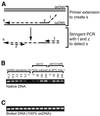Quantitative amplification of single-stranded DNA (QAOS) demonstrates that cdc13-1 mutants generate ssDNA in a telomere to centromere direction
- PMID: 11691929
- PMCID: PMC60175
- DOI: 10.1093/nar/29.21.4414
Quantitative amplification of single-stranded DNA (QAOS) demonstrates that cdc13-1 mutants generate ssDNA in a telomere to centromere direction
Abstract
We have developed a method that allows quantitative amplification of single-stranded DNA (QAOS) in a sample that is primarily double-stranded DNA (dsDNA). Single-stranded DNA (ssDNA) is first captured by annealing a tagging primer at low temperature. Primer extension follows to create a novel, ssDNA-dependent, tagged molecule that can be detected by PCR. Using QAOS levels of between 0.2 and 100% ssDNA can be accurately quantified. We have used QAOS to characterise ssDNA levels at three loci near the right telomere of chromosome V in budding yeast cdc13-1 mutants. Our results confirm and extend previous studies which demonstrate that when Cdc13p, a telomere-binding protein, is disabled, loci close to the telomere become single stranded whereas centromere proximal sequences do not. In contrast to an earlier model, our new results are consistent with a model in which a RAD24-dependent, 5' to 3' exonuclease moves from the telomere toward the centromere in cdc13-1 mutants. QAOS has been adapted, using degenerate tagging primers, to preferentially amplify all ssDNA sequences within samples that are primarily dsDNA. This approach may be useful for identifying ssDNA sequences associated with physiological or pathological states in other organisms.
Figures








References
-
- Sassanfar M. and Roberts,J.W. (1990) Nature of the SOS-inducing signal in Escherichia coli. The involvement of DNA replication. J. Mol. Biol., 212, 79–96. - PubMed
-
- Bishop D.K., Park,D., Xu,L. and Kleckner,N. (1992) DMC1: a meiosis-specific yeast homolog of E.coli recA required for recombination, synaptonemal complex formation and cell cycle progression. Cell, 69, 439–456. - PubMed
-
- Lydall D., Nikolsky,Y., Bishop,D.K. and Weinert,T. (1996) A meiotic recombination checkpoint controlled by mitotic checkpoint genes. Nature, 383, 840–843. - PubMed
Publication types
MeSH terms
Substances
Grants and funding
LinkOut - more resources
Full Text Sources
Other Literature Sources
Molecular Biology Databases

